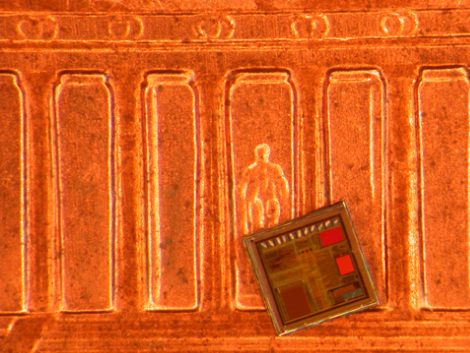By Brian Santo, contributing writer
You know what’s awesome? Nano technology. Nanotubes are awesome. Nanoparticles are awesome. Nanobots are really awesome. You know what ceased to be awesome a long time ago? Micro anything. You got your microphones and your microprocessors and your Microsoft. Micro is so 1983. Nano motes would be awesome. Instead, a bunch of researchers in one of those seemingly innumerable states in the middle of the country that begins with an M decided to call their tiny, ultra-low-power computers “micro motes.” Which is a shame, because they’re kind of awesome.
Micro motes are autonomous, fully functional electronics systems measured in millimeters. They include fully functional autonomous computers that can be integrated with any number of sensors. They can be self-powered. They can communicate wirelessly.
They’re the product of the Michigan Micro Mote (M3 ) project at the University of Michigan. Aside from the low power consumption, there’s little leading-edge technology involved, but that’s one of the attractive things about them.
The promise of the Internet of Things (IoT) was supposed to be that everything would become smart. Those expectations were quickly reined in when people started calculating the costs of deploying, powering, and maintaining that much processing power. Even traditional embedded processors — designed to be cheap enough to use in printers, rice cookers, digital cameras, and the like — would be too expensive to deploy and maintain in IoT applications.
Micro motes are still in the development stage, but they merit excitement because they could be relatively inexpensive to build and operate and could make the things in the Internet of Things as smart as originally imagined.
They might also solve a problem before it arises. It’s commonly assumed that trillions of IoT sensors could get deployed within the next few decades. If they were all dumb sensors, each might not produce much data, but the aggregate of raw data from trillions could swamp data centers, which are perpetually scrambling to keep up with demand. If micro motes were to be deployed, that would mean that much less pressure on data centers.
Researchers in the M3 program have devised a set of modules with different functions that can be combined as necessary and stacked in a package.

Pictured above is the low-power Phoenix processor on a penny. Image source: University of Michigan.
The key innovation with these things is that they run on exceedingly little power. The processor (called Phoenix) can operate on a few nanowatts. With a built-in standby mode, the power draw averages a mere 500 picowatts, the researchers said.
Power is provided by a solar cell, measuring 1 mm2 , that can provide up to 20 nanowatts even with ambient light. The solar cell module also includes a photo cell that can be used for optical communications.
There’s also a battery module, and a module for radio communications. Integration with just about any type of sensor is possible. For example, the researchers have developed a micro mote with a MEMS (micro electro mechanical system) pressure sensor to monitor intraocular pressure in glaucoma patients and intercranial pressure in trauma victims. These devices can be injected; in contrast, the current monitoring practice with trauma patients is the insertion of a wire.
Recent advances in micro mote technology include reducing the size down to a cubic millimeter, the addition of up to a megabyte of flash memory, and the improvement of antenna broadcast range from 7 meters in 2015 to 20 meters today. All three advances were reported at the most recent ISSCC conference.
The memory work was reported with Taiwan Semiconductor Manufacturing Co. The presenters said the inclusion of a relatively large amount of memory makes micro motes suitable for deep neural networks. The involvement of TSMC, one of the most advanced IC fabs in the world, is a good sign that there will be ongoing progress on building micro motes inexpensively and in bulk.
There are at least three startups, most with ties to the University of Michigan, founded within the last five years to commercialize micro motes. They include Ambiq Micro (specializing in ultra-low power ICs, including microcontrollers), Psikick (ultra-low power sensors), and CubeWorks (millimeter-scale wireless computing).
They’re all trying to relabel these things “smart dust,” but it might be too late. “Micro motes” is beginning to sound groovy in a retro sort of way.
Advertisement
Learn more about Electronic Products Magazine





